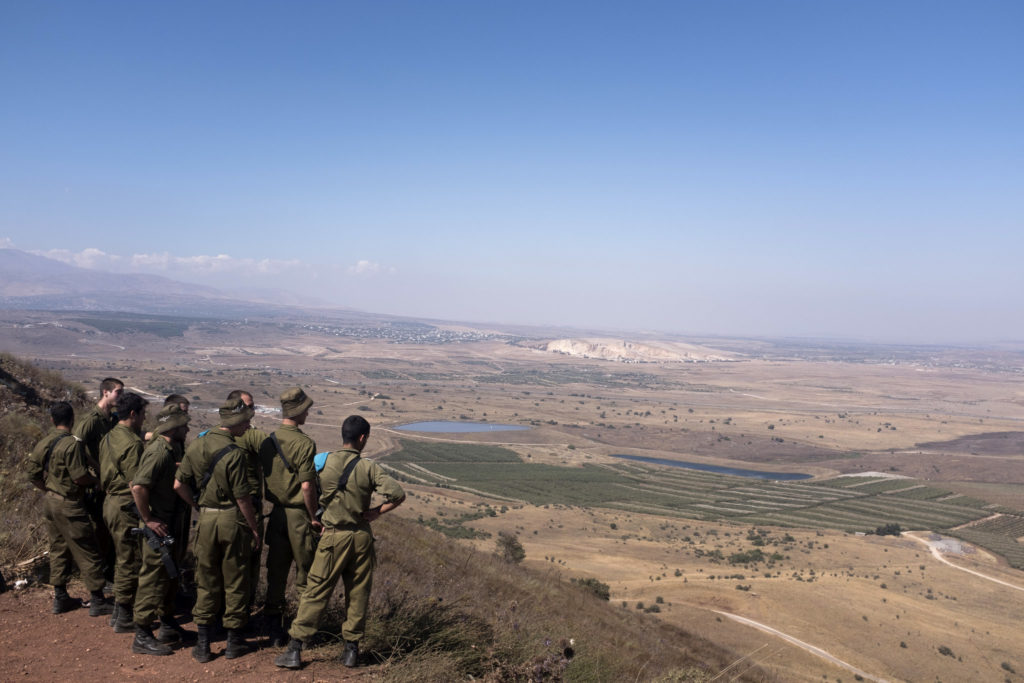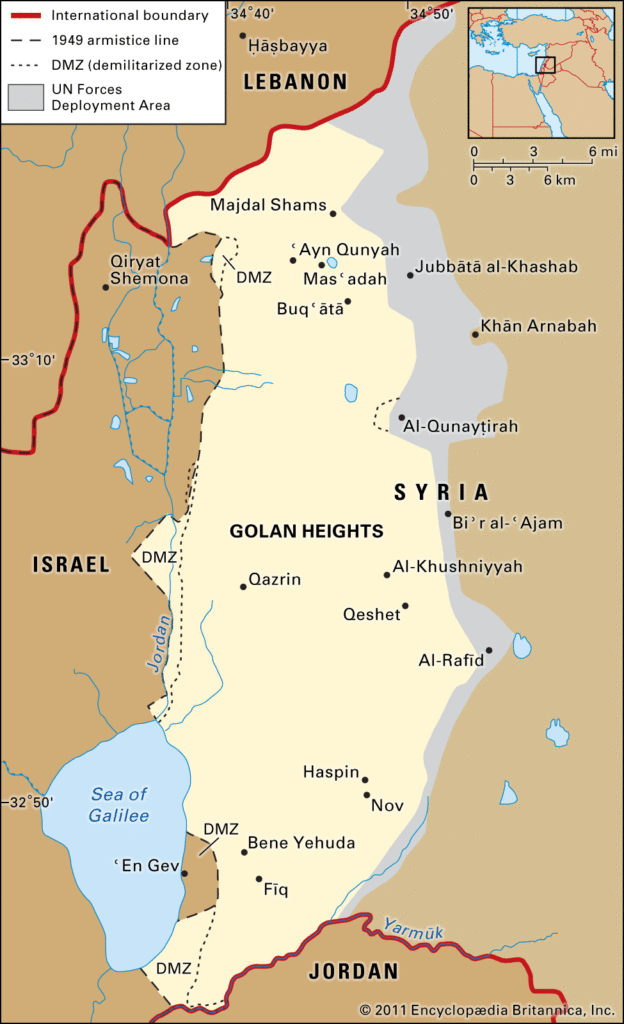Australia/Israel Review
Essay: Legal Heights
Dec 24, 2019 | Greg Rose

International law and recognising Israeli sovereignty over the Golan
On March 25, 2019, the USA formally recognised Israeli sovereignty over the Golan Heights. Was this action sound under international law and, if so, should other countries do likewise?
United States Recognition of Israeli Sovereignty and the Responses
The White House recognised the Golan Heights as under Israeli sovereign territory when US President Donald Trump issued an executive directive on March 25, 2019. The proclamation was consistent with a US policy stance that has existed for almost a half-century. In 1975, the Ford Administration wrote a letter to Israeli Prime Minister Yitzhak Rabin stating that “a peace agreement must assure Israel’s security from attack from the Golan Heights” and that the USA “will give great weight to Israel’s position that any peace agreement with Syria must be predicated on Israel remaining on the Golan Heights.” Letters of assurance confirming this policy were written during the HW Bush and Clinton Administrations.
The formal recognition by the White House of Israeli sovereignty in the Golan Heights was condemned, however, by European Union countries, Russia, Iran and Syria. Russia and Iran are Syrian military allies with shared interests in the Syrian civil war, and the objections of the European Union member countries appear driven by foreign policy doctrine. In contrast to fierce condemnation in December 2017 of the White House recognition of Jerusalem as the capital of Israel, there were no condemnatory resolutions passed in the United Nations.
Historic and Geographic Background
Geographically, the Golan Heights is mostly a volcanic basalt plateau, where the peak of Mt Hermon rises to 2,814m. Its area is 1,800 km2, of which Israel controls the western two thirds, i.e. 1,200 km2. Its precipitation is higher than the regional average, and includes snow that supplies much of the Jordan River watershed and the Sea of Galilee, which provides 30% of Israel’s fresh water. Thus, the Golan Heights is strategically important as a regional source of fresh water.
Syria controlled the Golan Heights as sovereign from 1946 (when French colonial troops left) until 1967, i.e. for 21 years. Israel has since 1967 controlled the Golan Heights as occupying power, i.e. for 52 years.
Currently, the population of the Israeli-controlled western Golan Heights is predominantly Druze, numbering 27,000, who share the Golan Heights with 22,000 Jewish citizens of Israel. About 10% of the Golan Druze have chosen Israeli citizenship, while the others have Israeli residence, social security and travel rights. The younger generation inclines more toward their fellow Druze in Israel and loyalty to Israel.
 Military/Strategic Significance
Military/Strategic Significance
The military-strategic importance of the Golan Heights is fundamental. It overlooks Israeli villages southward and westward, providing dominating vantage points for surveillance and fortified positions for launching rockets and artillery into Israel below. A line of volcanic hills provides a defence against attacks from Damascus.
In the 1948 war against the establishment of Israel, Syria made use of the strategic advantages of the Golan Heights. Early in the war, Syria advanced into and occupied two pockets of the former British Mandate territory and fortified the Golan region with networks of bunkers, tunnels and artillery positions that provided launching positions for thousands of artillery attacks and terrorist raids into Israel from 1949 to 1967.
On June 5, the first day of the 1967 Six Day War, intense Syrian shelling of Israeli villages and military positions on the Galilee below the Golan commenced, together with bombing by Syrian aircraft. On June 9, Israeli airplanes and ground forces advanced on the Golan Heights, taking control of them in a clearly defensive response.
The 1973 October War was launched by Syria and Egypt. Israel gained further territory in the north-eastern Golan Heights than in 1967, but drew back from those positions, and from the Golan area around Quneitra occupied in 1967, in favour of the establishment there of a demilitarised zone under UN supervision.
Since 2018, the Iranian Islamic Revolutionary Guard Corps (IRGC) and its proxy militia Hezbollah have reportedly established bases in the eastern Golan Heights region under Syrian control. Their presence, given Iran’s stated purpose of “erasing Israel from the map,” currently involves a large-scale military build-up and occasional rocket strikes on Israel, and Israeli bombing of their munitions bases.
International Law and United Nations Resolutions
The 1949 Israel-Syria ceasefire agreement emphasised, in accordance with Syrian demands, that
“the following arrangements for the Armistice Demarcation Line between Israeli and Syrian armed forces are not to be interpreted as having any relation whatsoever to ultimate territorial arrangements affecting the two Parties to this Agreement.”
No sovereign border was set and the demarcation line was abrogated by Syrian resumption of hostilities in 1967 and 1973.
Israel is a party to the Fourth Geneva Convention on Protection of Civilians 1949. It provides that “penal laws of the occupied territory shall remain in force” (Article 64). Thus, Israel is legally bound to maintain Syrian penal and civil law in the Golan Heights, until such time as it withdraws from the area or formally annexes it as sovereign territory.
Israel has not formally annexed the western Golan Heights, but in 1981 passed a law tantamount to annexation. In response to the Israeli Golan Heights Law, passed on December 14, 1981, the UN Security Council (UNSC) promptly met on Dec. 17, 1981 and unanimously adopted Resolution 497 under Chapter VI of the UN Charter, which empowers the Security Council to adopt recommendations not entailing coercive measures. It states that
“the Israeli decision to impose its laws, jurisdiction, and administration in the occupied Syrian Golan Heights is null and void and without international legal effect.”
The Security Council reconvened four weeks later to consider sanctions under Chapter VII of the Charter. A draft resolution called for complete suspension of relations by all countries with Israel. The USA vetoed the proposed Security Council sanctions. It considered that the Golan Heights Law was a breach of the Fourth Geneva Convention, but also that the Golan Heights had not formally been annexed.
In response, on Jan. 29, 1982, a UN General Assembly (UNGA) emergency special session adopted Resolution 37/123A, which deplored the United States veto and called upon all states and international agencies to boycott Israel, as discussed below.
Syria demands the full return to Syria of the Golan Heights as a precondition to any discussion of recognition of or peace with Israel. Fresh Israeli overtures for peace negotiations with Syria occurred in 1992, 1995, 2000 and 2008 but were unsuccessful. In contrast, peace treaties were agreed with Israel by Egypt in 1979 and by Jordan in 1994.
Evaluation of the Legal Implications
Eleven observations evaluating legal implications follow from the above summary of Israeli law, the international treaty law and the UN resolutions.
At the time of the Golan Heights Law in 1981, the Israeli government maintained that it was not in itself formal, de jure, annexation. Subsequently, Israel initiated negotiations to hand the Golan Heights to Syria in consideration of a peace treaty and security guarantees in 1992, 1996, 2000 and 2008. Thus, annexation has not clearly occurred and the formal legal situation remains ambiguous.
The Golan Heights were annexed in a de facto manner by the application of Israeli domestic law in 1981. In early 2016, the Israeli Government declared, again informally and in light of Syrian instability and history of hostility, that the Golan Heights will remain part of Israel.
The Israeli 1981 Golan Heights Law is implemented in breach of the international laws of occupation, specifically Article 64 of the Fourth Geneva Convention on Protection of Civilians and Section 3 of the Hague Convention IV 1907 Regulations, Annex. However, that breach is not one considered a grave breach under international laws of armed conflict; i.e. it is not specified in the Fourth Geneva Convention on Protection of Civilians as one to which sanctions apply, nor as one of a criminal nature under the Rome Statute of the International Criminal Court.
The international laws of armed conflict continue to apply in the Golan Heights. Israeli occupation of the Golan Heights was self-defence in response to wars initiated by Syria and it continues as a legitimate ongoing occupation in the absence of peace.
Syrian sovereignty has been superseded across half a century. Legal philosophers suggest that changing circumstances on the ground cause a shift in applicable ethical factors. The interests of the 22,000 Jews now living in the Golan Heights, and of increasing numbers of the Druze population there who are against transfer to Syria, must be considered.
None of the relevant UNSC resolutions explicitly requires return of the Golan Heights to Syria. Rather, they are premised on the notion of negotiation of territories for peace. In the wake of the June 1967 war, Resolution 242 of November 22, 1967 refers in its preamble (which is not an operative provision) to “the inadmissibility of the acquisition of territory by war” – but that must be read consistently with international law as meaning acquisition by aggression rather than self-defence (see point 10 below).
The relevant UNSC resolutions are recommendations without inherent coercive effect. Resolutions 242 and 497 do not follow the common practice of Chapter VII resolutions by stating explicitly that they are adopted under it. In fact they are adopted under Chapter VI of the UN Charter and are therefore merely recommendations. According to the International Court of Justice (Namibia Advisory Opinion), a legal consequence might flow from a declaration of illegality only if the resolution was coercive.
UN General Assembly resolutions on matters of international peace and security, such as Resolution 37/123A, are recommendations that lack power under the Charter to create obligations that are legally binding for member states.
UNGA resolutions by themselves do not form international law, as declared in the Libya v Texaco arbitration. Additionally, principles of law are by nature of general application and cannot be particular to Israel or exclusive to the Golan Heights.
International law has not, in the past, rewarded perpetrators of wars of aggression. States that failed in their wars of aggression in World Wars I and II suffered territorial losses. The International Law Commission in 1950 endorsed the legality of conquest of territory, unless by aggression or in violation of the UN Charter. This was the law still in 1967 when Israel took the Golan Heights in a defensive war. An inviolate Syrian right to the Golan Heights, despite three aggressive wars and repeated lesser assaults on Israel, would grant an aggressor reward for illegal acts and is plainly wrong – legally, politically and morally.
The UN International Law Commission has recognised lawful “situations of necessity” that legitimate actions that might otherwise be considered unlawful. By implication, Israeli control of the Golan Heights, at least of the slopes looking south and west into Israel, is a military necessity, due to the vulnerability to hostility from Syria of Israeli lowlands.
In conclusion, an Israeli de jure annexation of the Golan Heights would be lawful in the cumulative circumstances described above. It would cure the illegality under the laws of military occupation of the Golan Heights Law, as the military occupation would formally terminate upon annexation transferring sovereignty over the Golan Heights to civil government in Israel.
Wider Recognition of Israeli Sovereignty over the Golan Heights
Should other countries follow the USA to recognise Israel’s de jure sovereignty over the Golan Heights? Principles of international law set out notionally universal rules applicable to all countries. Security, economic and ethical considerations might vary for every country according to the unique situation of each.
Considering security, would continuing Israeli control of the Golan Heights increase or decrease the likelihood of war with Syria? The history shows that Syria initiated war with Israel twice during the 21 years it controlled the Golan Heights and has since been embroiled in a decade of civil war, and that there has been no war there during the last 47 years under Israeli control.
On evaluation of international relations ethics, Syria has a weak case. It launched aggressive wars, allegedly commits war crimes against its own citizens, is a politically unstable military dictatorship propped up by foreign hegemons (Iran and Russia), and dominated internally by extremist militias. Syria resists negotiations to make peace and facilitates the entrenchment of foreign militias for future assaults on Israel.
In relation to political risk, the lack of significant Arab protest against the recognition of Israeli sovereignty by the Trump White House suggests that the risk is small. Syria is aligned with Persian and Shi’ite Iran against the Sunni Arab population and is currently suspended from the Arab League. An argument against recognition is that the political status quo has been satisfactory for a half-century: it forestalls regional war, maintains Israeli control, and avoids potential retaliation. Yet, ambiguity around the legality of Israeli control is impossible to maintain indefinitely. A forward-looking political analysis is that non-recognition contributes to instability and in the longer term is a source of danger.
Recognition of Israeli sovereignty might carry risks of economic and trade boycotts. Yet Syria is a minor economy and its Iranian and Russian allies provide little foreign development aid. Trade and aid from the European Union to developing countries are unlikely to be affected because recognition of Israeli sovereignty over the Golan Heights is not a central concern in European bilateral relationships. In contrast, renewed Syrian armed attacks on Israel from the Golan Heights could trigger rippling regional wars, leading to trade destabilisation and energy price inflation.
Conclusion
The legal case for recognising the legality of Israeli annexation of the Golan Heights is strong. In deciding whether to recognise Israeli sovereignty over the Golan Heights, the security, ethical and legal considerations are essentially common for all countries. Economic or political retaliation risks are particular to each country’s situation, and might be points of vulnerability. However, the risks of economic or political retaliation are negligible. Recognition of Israeli sovereignty in the Golan Heights is both legally sound and opportune.
Dr Gregory Rose is Professor in the School of Law at the University of Wollongong, where he specialises in international law.
Tags: Golan Heights, Israel, Syria






